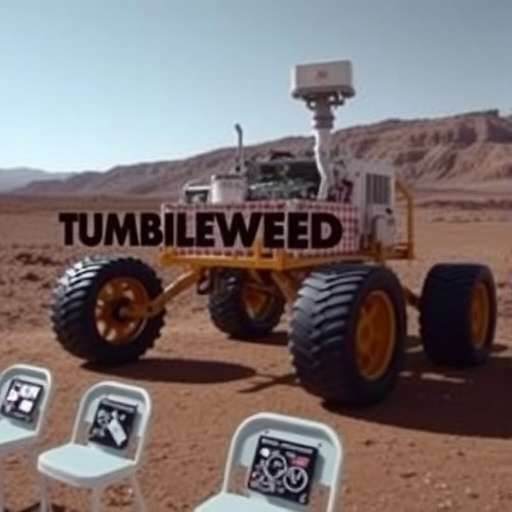In a groundbreaking stride toward revolutionizing planetary exploration, researchers have unveiled compelling evidence supporting the viability of spherical wind-driven rovers—known as Tumbleweed rovers—as a low-cost, large-scale solution for Martian surface exploration. This innovative approach was detailed at the Joint Meeting of the Europlanet Science Congress and the Division for Planetary Sciences (EPSC-DPS) 2025, highlighting recent experimental campaigns that validate the rovers’ mobility and data-gathering capabilities in Mars-analog environments.
These robotic spheres, approximately five meters in diameter in their operational form, are uniquely designed to harness Martian wind dynamics for propulsion across the Red Planet’s varied terrain. Unlike traditional wheeled rovers that rely on onboard power and locomotion systems, Tumbleweed rovers capitalize on aerodynamic principles, allowing them to be propelled by Mars’ persistent wind currents. This passive mobility represents a significant paradigm shift, potentially enabling expansive, autonomous svarming across vast geographic swaths that current rovers cannot practically cover.
Recent tests conducted at Aarhus University’s Planetary Environment Facility employed scaled prototypes of 30, 40, and 50 centimeters in diameter, subjecting them to a spectrum of wind velocities and surface conditions within a controlled wind tunnel environment simulating Mars-like atmospheric pressure of approximately 17 millibars. These meticulous experiments demonstrated that wind speeds as low as 9 to 10 meters per second are adequate to induce rolling motion over diverse simulated Martian surfaces, including granular sand, pebbles, and rocky boulder fields—this affirms the rovers’ ability to negotiate the unpredictable and often treacherous Martian landscape.
Intriguingly, the field tests extended beyond laboratory settings to a quarry in Maastricht, Netherlands, where a 2.7-meter prototype—equipped with modular scientific payloads including cameras, magnetometers, inertial measurement units, and GPS—successfully collected and transmitted environmental data in real-time while tumbling across natural terrain. These tests underscored the rover’s robustness and capacity for in-situ scientific operations, crucial for expanding humanity’s understanding of Martian environmental and atmospheric processes.
Beyond merely rolling across the surface, Tumbleweed rovers have demonstrated the capacity to navigate slopes that, when scaled to Mars’ gravity and terrain, represent inclines as steep as 30 degrees. Such mobility defies the limitations of conventional rover designs, which often encounter difficulties when tackling steep or unstable slopes, thus significantly broadening the range of accessible exploration zones.
One of the study’s notable implications lies in the extrapolated mobility range. Using data derived from the Aarhus tests in conjunction with atmospheric datasets from NASA’s Insight lander and Ingenuity helicopter, researchers estimate that an average Tumbleweed rover could traverse distances exceeding 400 kilometers over 100 Martian sols (about 100 Earth days), averaging speeds near 0.36 kilometers per hour. Under optimal wind scenarios, this range could surge to approximately 2,800 kilometers, highlighting the immense exploratory footprint these rovers could achieve autonomously.
The biological analogy of rolling tumbleweeds, familiar on Earth’s plains, belies the technical sophistication embedded in the rover design. Their spherical geometry minimizes resistance and promotes aerodynamic mobility, while integrated scientific instrumentation within the hollow interiors enables a suite of environmental and atmospheric measurements. After traversing the critical phases of movement, the rovers are designed to collapse into more compact, stationary measurement stations, serving as long-term data nodes emplaced across Mars’ surface to monitor environmental variables with sustained precision.
Current knowledge gaps in near-surface Martian wind patterns, as evidenced by the limited yet revealing datasets from existing landers and airborne vehicles, underscore the importance of deploying a distributed sensor network. Tumbleweed rovers, through their swarming ability, promise to provide spatially and temporally rich datasets, filling crucial observational voids. This could enhance our understanding of atmospheric turbulent processes, dust mobilization, and local climate dynamics which are vital for both scientific inquiry and mission planning.
The multidisciplinary Team Tumbleweed, composed of young scientists from more than 20 countries and headquartered in Vienna and Delft, is spearheading the advancement of this technology. Their efforts extend beyond prototyping and field validation to refining dynamic models of rover behavior and developing more sophisticated, lightweight instrumentation. Future campaigns planned include larger-scale field tests in the Mars-analog Atacama Desert, where swarm coordination strategies and instrument payloads will be rigorously evaluated.
Such innovations represent a significant leap not only for planetary science but also for the engineering of autonomous exploration systems. Through integration of environmental physics, robotics, sensor technology, and atmospheric science, Tumbleweed rovers epitomize a convergence of disciplines aimed at overcoming the formidable challenges of extraterrestrial mobility and long-duration surface data collection.
In this context, the prevailing experimental results offer compelling optimism. The successful demonstration of the Tumbleweed concept in controlled and natural Earth environments forms a robust foundation for further development. Moreover, the potential scalability of this technology to accommodate diverse scientific payloads opens avenues for multi-mission adaptability, potentially fitting roles in geological surveys, atmospheric sampling, and infrastructure support for future human missions.
In summary, the Tumbleweed rover initiative harnesses a blend of innovative engineering and scientific foresight, promising to transform our methods of exploring Mars from isolated, limited traverses to expansive, persistent swarming networks. The pathway from laboratory validation to planetary deployment underscores the growing trend of biomimicry and environmental integration in robotic exploration, elucidating a future where planetary surface missions are not only feasible but prolific and far-reaching.
Subject of Research: Mars Surface Exploration via Wind-Propelled Spherical Rovers
Article Title: Wind-Driven Tumbleweed Rovers Poised to Revolutionize Mars Surface Exploration
News Publication Date: 2025
Web References: https://mediasvc.eurekalert.org/Api/v1/Multimedia/2e247bf6-976e-44d6-a8c5-de3540d0f439/Rendition/low-res/Content/Public
Image Credits: Team Tumbleweed
Keywords: Mars rovers, Mars, Wind speed, Planetary exploration, Autonomous robotics, Martian atmosphere, Swarm robotics




